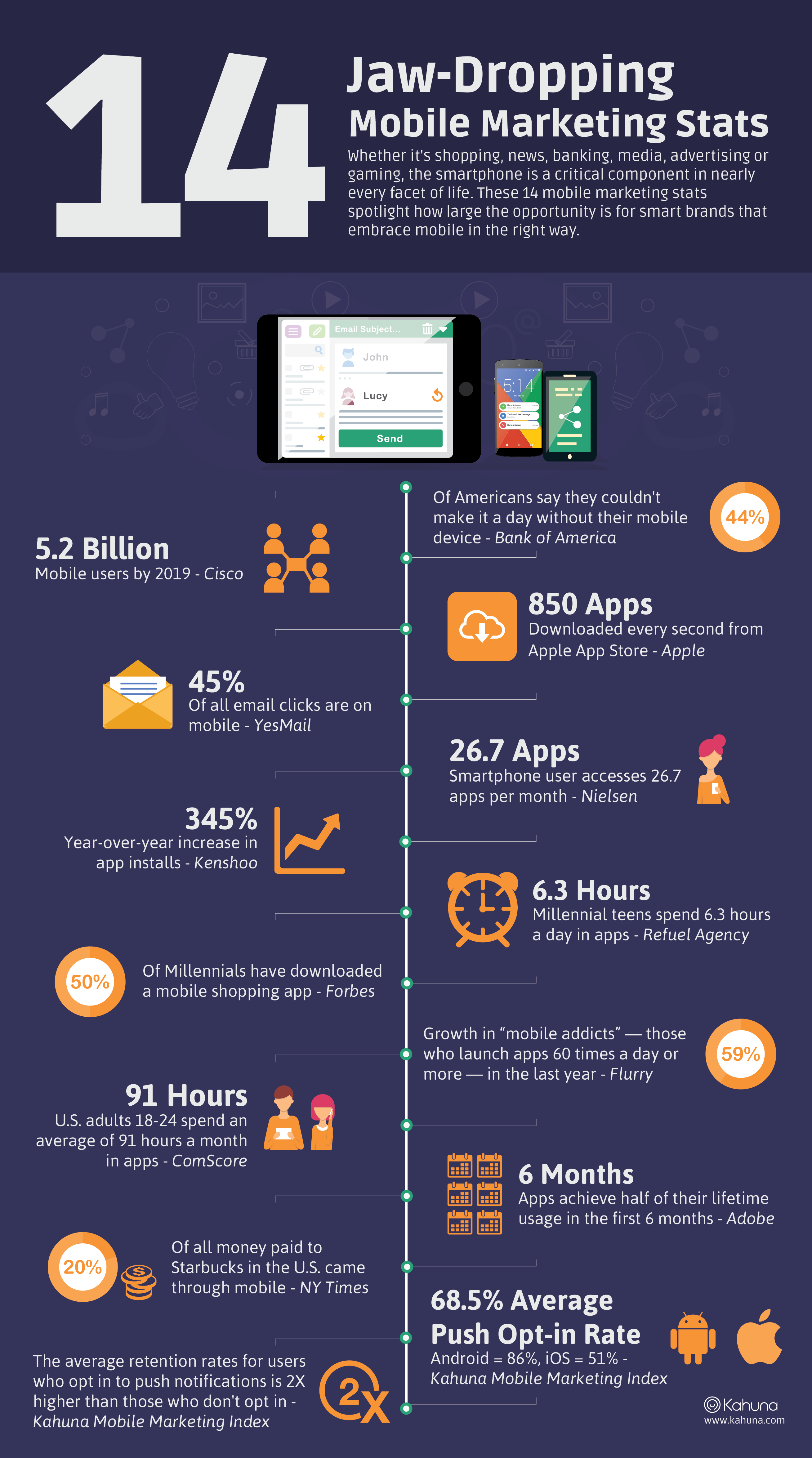Monopolize on Mobile Phone Dependence
In a previous blog post, we talked about the evolution of mobile marketing, analyzing how advancements in smart phone technology opened up opportunities for mobile marketers to flash their banner ads and push their push notifications. In this post, we’re going to talk more about how a mobile marketing agency can take advantage of one of the fastest growing ad platforms out there.
Smart Phone Dependence
How many times a day do you look at your mobile phone? Does the sound of the default iPhone ringtone cause an immediate reaction in you? Does the little red notifications circle in the corner of an app drive you insane? Are we pre-programmed to be dependent on our mobile device, or have social norms forced phone obsession on us? More importantly though, how can marketers take advantage of this?
To make sense of our reactions, it’s first important to understand how classical conditioning plays a role in how we interact with technology. A hundred years ago, a repeated vibrating noise would have been a cause for concern, not an immediate reach for your purse. We’ve become so attached to our devices that our bodies react to certain sounds without us even realizing it. Imagine if you had the ability to send out an ad for your service that, rather than repelling your customer base, beckoned to them like the tempting toll of an ice cream truck. Email and push notifications make a mobile phone user feel acknowledged and appreciated. When you check your phone after a 30-minute break and realize you don’t have any notifications, you may feel unloved and invisible. A notification, even from a brand trying to get your business, helps alleviate that feeling. Sure, this monopolizes on an unhealthy, dependent relationship between a consumer and their phone, but at least both parties are getting something out of it. A good mobile marketing agency will know the perfect time of day to leverage high mobile phone usage and the right wording to draw in business.
Avoiding Reality
This article about our obsession with mobile phones (published in 2015) goes into the psychology behind the phenomenon, analyzing whether we check our mobile device for the sake of pleasure or real-life social avoidance. In one poll, almost half of the 15,000 adult smartphone users surveyed said they checked their phone a few times every hour. Among 18 to 29-year-olds, 22% checked their phone every few minutes. Why is this? Larry Rosen Ph.D. claims that our obsessive desire to not ‘miss out’ on what’s going on is what motivates this behavior. Ironically, constant mobile phone immersion is what keeps us from participating in the very thing we’re trying to engage with—the real world. Rosen claims that the primary emotion driving our obsession is the feeling of relief we get from feeling ‘included’. Since an obsession is built around performing an act that reduces your feeling of anxiety, phone usage could qualify as an obsession. In fact, many believe that we use our phone as a shield against having to interact with the people around us. This might be due to social anxiety or social phobia, but it could also just be compliance to a social norm. If we see everyone around us on their phones, it’s hard not to give into the peer pressure. This hidden camera social experiment shows just how powerful peer pressure can be:

Mobile Marketing Applications
Alright, now that we’ve established why mobile phones are such a great marketing tool, let’s take a look at how you can use this device to your advantage through a mobile marketing agency.
Quality Over Quantity When It Comes to Mobile Apps
It’s better to have a handful of users that are dedicated to your app than thousands who will use your app once and then delete it. Getting a million downloads may look good in the app store, but it doesn’t provide you with in-app purchases or monthly subscriptions that go beyond the trial period. If you have an ecommerce app, you want users who are actually going to make a purchase on your app. By creating mobile web first, you can attract a broad audience and funnel in the serious fans through the app. A mobile marketing agency can help you link your mobile web version and mobile app.
Mobile Messaging Options
It can be awkward and overly-formal trying to compose an email to send to a business. That’s why mobile messaging apps are the perfect solution to create casual relationships with your customers. Apps like WhatsApp, Snapchat and Facebook Messenger provide the perfect outlet for customer service questions (since no one likes sitting on hold for 30 minutes). In addition to personalized assistance, in-app chatbots are a great option for smaller companies that can’t afford to have someone maintain mobile messaging channels. A chatbot is “a service, powered by rules and sometimes artificial intelligence, that you interact with via a chat interface” according to Chatbots Magazine. These chatbots are mostly found in messaging apps, like Facebook Messenger, and help you place orders or answer questions. Essentially, they make it easy for you to categorize questions so they reach the right person.
Location-based Technology
We’ve said it a million times—if a mobile marketing agency isn’t using location-based technology to target your ads to the right people, they’re dummies (it just so happens that we’re not dummies, and you can contact us for definitive proof). This article on Bluetooth Low Energy beacons (proximity beacons) says the device will “transmit relevant, targeted messages and information to nearby mobile devices”. With location-based targeting, you can make it easy for users to purchase items and then pick up in stores or request items that are out of stock. Talk to a mobile marketing agency about utilizing geo fencing to send push notifications and promotional emails once someone enters a certain mile radius of your store. Convenience is key.
Ease of Use
It’s imperative that your user find what they’re looking for in three seconds. If your banner ad’s landing page takes longer than five seconds to load, you better bet it’s going to be abandoned after second three. You can create a seamless experience by carrying out user testing, split-testing feature enhancements, and allowing mobile-friendly payments. Google’s new Accelerated Mobile Pages (AMP) loads mobile pages quickly, improving your ranking in Google. Ease of use also includes user experiences, so it’s important to not bombard your user with a bunch of full-screen pop up ads once they get to your designated landing page. If you’re going to use pop up ads, it’s important to make sure that they only cover a small portion of the page.
Use Video in Your Mobile Marketing
Not only is video one of the most popular forms of online content, but it’s also the most shareable (92% of mobile video consumers share videos with others according to HubSpot). If you’re a car dealership that’s trying to promote the newest Buick truck, throw a summer event and invite truck lovers to bring their vehicles and fill the truck beds with water for a makeshift pool party. Then, film the event and invite a news crew to come out and broadcast the party. The easiest way to make a share-worthy video is to throw a share-worthy event.
People Love Emojis
A study that analyzed over 2.6 billion push notifications found that those with emojis had 85% greater open rates than those without. In fact, they’re even making a movie about emojis due to their popularity. We use emojis to lighten the mood, soften a blow, find a more comfortable way to express ourselves, and communicate when words fail us. Oddly enough, we react to emojis the same way that we react to real human expressions, indicating that we may actually be more inclined to give personalities/human-like qualities to the companies using them. In addition to higher open rates, emoji usage can also lead to higher conversion rates. Emojis that were A/B tested in push notifications actually led to a nine percent increase in users who clicked the notification’s call-to-action. According to App Annie, App Store revenue has jumped by 80% in the last year, and the time spent in-app has increased 95%. Millennials are the key market for emoji-powered push notifications, so bring tup this tactic with your mobile marketing agency if you have a younger target market.
And a Case Study To Round Things Off…
Who doesn’t love Dunkin’ Donuts? Okay, maybe there are a few people out there who can’t handle the sweet deliciousness that is a raspberry-filled powdered sugar donut, but you can at least give them credit for a great mobile marketing campaign. In 2012 (right when mobile marketing was becoming a thing), they launched a text messaging promotion that was geared toward young adults in Boston. As a result of their campaign, in-store traffic to their Boston locations jumped by 21%. To get the word out about their promotion, they had a local radio DJ advertise the text message promotion on air and ran mobile internet ads. There were 7,500 consumers that opted-in to receive text promotions due to their mobile marketing efforts. Not only did it have the short-term effect of getting people through the door for their promotion, but 35% claimed they were more likely to buy lattes and coffee from Dunkin’ Donuts in the future because of the text message promotion. Now that’s what we call a slam dunkin’.
Contact Us
If you’re interested in working with a mobile marketing agency to generate revenue for your business, you’ve come to the right place. Contact us for more information on how we can help make your mobile marketing dreams a reality, or check out our mobile marketing page to learn more about the services we offer.






